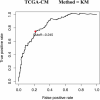Prediction of clinical prognosis in cutaneous melanoma using an immune-related gene pair signature
- PMID: 34047683
- PMCID: PMC8806557
- DOI: 10.1080/21655979.2021.1924556
Prediction of clinical prognosis in cutaneous melanoma using an immune-related gene pair signature
Abstract
Cutaneous melanoma (CM) is a malignant and aggressive skin cancer that is the leading cause of skin cancer-related deaths. Increasing evidence shows that immunity plays a vital role in the prognosis of CM. In this study, we developed an immune-related gene pair (IRGP) signature to predict the clinical prognosis of patients with CM. Immune-related genes from The Cancer Genome Atlas (TCGA) and the Gene Expression Omnibus (GEO) databases were selected to construct the IRGPs, and patients with CM in these two cohorts were assigned to low- and high-risk subgroups. Moreover, we investigated the IRGPs and their individualized prognostic signatures using Kaplan-Meier survival analysis, univariate and multivariate Cox analyses, and analysis of immune cell infiltration in CM. A 41-IRGP signature was constructed from 2498 immune genes that could significantly predict the overall survival of patients with CM in both the TCGA and GEO cohorts. Immune infiltration analysis indicated that several immune cells, especially M1 macrophages and activated CD4 T cells, were significantly associated with the prognostic effect of the IRGP signature in patients with CM. Overall, the IRGP signature constructed in this study was useful for determining the prognosis of patients with CM and for providing further understanding of CM immunotherapy.
Keywords: Cutaneous melanoma; immune-related gene pairs; prognosis.
Conflict of interest statement
No potential conflict of interest was reported by the author(s).
Figures






Similar articles
-
Predicting the clinical outcome of melanoma using an immune-related gene pairs signature.PLoS One. 2020 Oct 8;15(10):e0240331. doi: 10.1371/journal.pone.0240331. eCollection 2020. PLoS One. 2020. PMID: 33031392 Free PMC article.
-
A Novel Signature of 23 Immunity-Related Gene Pairs Is Prognostic of Cutaneous Melanoma.Front Immunol. 2020 Oct 19;11:576914. doi: 10.3389/fimmu.2020.576914. eCollection 2020. Front Immunol. 2020. PMID: 33193373 Free PMC article.
-
The Identification and Validation of a Robust Immune-Associated Gene Signature in Cutaneous Melanoma.J Immunol Res. 2021 Feb 19;2021:6686284. doi: 10.1155/2021/6686284. eCollection 2021. J Immunol Res. 2021. PMID: 33688507 Free PMC article.
-
Development and Validation of the B Cell-Associated Fc Receptor-like Molecule-Based Prognostic Signature in Skin Cutaneous Melanoma.Biomed Res Int. 2020 Aug 22;2020:8509805. doi: 10.1155/2020/8509805. eCollection 2020. Biomed Res Int. 2020. PMID: 32908921 Free PMC article.
-
Exploration of the immune cell infiltration-related gene signature in the prognosis of melanoma.Aging (Albany NY). 2021 Jan 10;13(3):3459-3482. doi: 10.18632/aging.202279. Epub 2021 Jan 10. Aging (Albany NY). 2021. PMID: 33428606 Free PMC article.
Cited by
-
A united risk model of 11 immune‑related gene pairs and clinical stage for prediction of overall survival in clear cell renal cell carcinoma patients.Bioengineered. 2021 Dec;12(1):4259-4277. doi: 10.1080/21655979.2021.1955558. Bioengineered. 2021. PMID: 34304692 Free PMC article.
-
Development and Validation of a Combined Ferroptosis and Immune Prognostic Model for Melanoma.J Oncol. 2022 Nov 24;2022:1840361. doi: 10.1155/2022/1840361. eCollection 2022. J Oncol. 2022. PMID: 36467505 Free PMC article.
-
A BRAF mutation-associated gene risk model for predicting the prognosis of melanoma.Heliyon. 2023 May 2;9(5):e15939. doi: 10.1016/j.heliyon.2023.e15939. eCollection 2023 May. Heliyon. 2023. PMID: 37205993 Free PMC article.
-
Immune-related risk score: An immune-cell-pair-based prognostic model for cutaneous melanoma.Front Immunol. 2023 Feb 15;14:1112181. doi: 10.3389/fimmu.2023.1112181. eCollection 2023. Front Immunol. 2023. PMID: 36875110 Free PMC article.
-
Targeting tumor-associated macrophages: Novel insights into immunotherapy of skin cancer.J Adv Res. 2025 Jan;67:231-252. doi: 10.1016/j.jare.2024.01.013. Epub 2024 Jan 17. J Adv Res. 2025. PMID: 38242529 Free PMC article. Review.
References
-
- Siegel RL, Miller KD, Jemal A.. Cancer statistics, 2016. CA Cancer J Clin. 2016;66:7–30. - PubMed
-
- Ross MI, Gershenwald JE. Evidence-based treatment of early-stage melanoma. J Surg Oncol. 2011;104:341–353. - PubMed
-
- Luke JJ, Flaherty KT, Ribas A, et al. Targeted agents and immunotherapies: optimizing outcomes in melanoma. Nat Rev Clin Oncol. 2017;14:463–482. - PubMed
MeSH terms
LinkOut - more resources
Full Text Sources
Other Literature Sources
Medical
Research Materials
